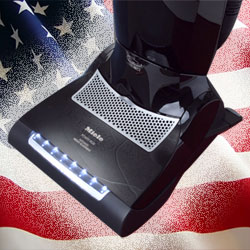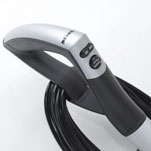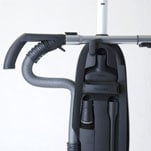 According to the U.S. Census Bureau, the value of shipments for household vacuum cleaners (including parts and attachments) was $3.02 billion in 2000. That figure rose from the 1992 total of $1.81 billion. And while nearly every single household in America has a vacuum cleaner, this continues to be a very lucrative business with all types of sales and marketing options.
According to the U.S. Census Bureau, the value of shipments for household vacuum cleaners (including parts and attachments) was $3.02 billion in 2000. That figure rose from the 1992 total of $1.81 billion. And while nearly every single household in America has a vacuum cleaner, this continues to be a very lucrative business with all types of sales and marketing options.
The traditional upright vacuum cleaner sales market outpaces the canister market by a margin of nearly four to one. That means that roughly 80% of Americans buy an upright vacuum cleaner over a canister style vacuum. While canister vacuums have many advantages, why do Americans typically favor the upright? To understand the psychology behind this consumer decision, you have to take a hard look at the history of vacuum cleaners in the United States.
In the late 19th and early 20th century, innovation drove the American economy. New inventions like the telephone and the automobile were changing the culture and creating new wealth for the country. Anyone with an idea to improve the quality of everyday life had a chance to succeed.
One example of an innovative mind at work is the story of H. Cecil Booth. When people still mostly traveled by train and city streets were dirt-packed and mud covered, the amount of dust in carriages, trains, and homes was overwhelming. On a train trip, Booth noticed that train workers were using a device that blew the dust from the seats. It seemed obvious, but the dust remained in the car
Moving the dust was not the best solution; removing the dust was. Booth could see that and tested his idea by taking his handkerchief and using his own suction power to collect dirt on the underside of the cloth. He was able to get a patent for his idea in 1901.
Booth built a monstrous vacuum cleaner that had to be mounted on a cart and pulled by horses through the streets of London, England. The machine was parked outside of a building, and a 100 foot hose was hauled into the building to do the cleaning, while suction was produced by a large pump.
Booth understood that a vacuum cleaner works because the machine causes a difference in air pressure. Suction is created when the motor runs a pump that reduces the air pressure inside the vacuum. The pressure of the atmosphere pushes, as the lack thereof in the canister pulls, the air through the carpet and into the tube. The physics of the action are comparable to how a drinking straw works. In a conventional upright vacuum cleaner, the dust actually is pushed into the tube and into a dust bag.
A second innovation in vacuum cleaner design occurred a few years later in Canton, Ohio. James Spangler, a janitor, invented an electric vacuum cleaner from a fan, a box, and a pillow case. Spangler had the suction, but he also incorporated a rotating brush into his design. The rotating brush helped to loosen debris from the carpet and into the vacuums range of suction.
Spangler patented the design, but because of a lack of capital, he had to sell his design to W.H. Hoover. Hoover recognized that the vacuum cleaner could be marketed as a way to control dust and to prevent the spread of germs. Hoover developed the project and called his new company, The Electric Suction Sweeper Company. Over the past 100 years, the Hoover name has become synonymous with vacuum cleaners around the world.
 These first vacuum cleaners were very expensive relative to wages. Up until the middle of the 20th century, they were considered a luxury item. With an economic boom in the United States in the 1950s, an expanding middle class was able to afford two new luxury items: wall-to-wall carpeting and vacuum cleaners to clean them!
These first vacuum cleaners were very expensive relative to wages. Up until the middle of the 20th century, they were considered a luxury item. With an economic boom in the United States in the 1950s, an expanding middle class was able to afford two new luxury items: wall-to-wall carpeting and vacuum cleaners to clean them!
For generations, every household had carpeting in a majority of the rooms in the homes. Really, because of liquid spills, the kitchen was the only hold out against carpeting. Because the upright was the primary model being developed and produced in the U.S. it had a strong foothold that canister style vacuums never would have in the U.S. marketplace
Soon, door-to -door vacuum salesmen became an icon of American business and popular culture. Subsequent generations of Americans grew up with the uprights in the home, with many Americans never having seen a canister vacuum in operation, marketing statistics for the industry show that Americans have stuck with what they know the upright vacuum cleaner. Miele, a German company, has been gaining market share in the United States market by introducing quality canister vacuum cleaners that are excellent for allergy and asthma sufferers. Despite the market’s heavy lean towards uprights, Miele’s quality and usability have earned accolades and devoted customers in the U.S
Advancing their products further and putting the competition on notice, in 2008 Miele enters upright vacuum cleaner market by introducing an upright vacuum that provides great carpet cleaning ability with innovative features that have been overwhelmingly well received by canister vacuum users. By addressing and correcting the shortcomings of traditional upright vacuums, Miele has accomplished what inventors were trying to do in the days of Booth, Spangler, and Hoover–create a vacuum that can be used in every household to clean any type of flooring, fabric, and furniture.
 |
 |
 |
The Miele Dyanmic U1 upright vacuum cleaner (formerly S7) is a welcome and important addition to the landscape of the American market place. Buying a Miele is an investment in a cleaner home that in time will more than pay for itself. Miele has been able to show that by spending more on a quality vacuum on the front end that consumers actually save money in the long run.
For example, you could spend a $100 on a vacuum every year, or every other year; or you could buy a Miele for $700 for a vacuum that is tested to last up to twenty years.* While the vacuum cleaner market is continually being saturated by inexpensive imports, it remains to be seen if Miele can carve out a bigger piece of the pie in the competitive world of vacuum cleaner sales.
To date, the new Miele U1 uprights start off on a solid foundation whose success, as the success of any producer of quality products, lies in both Miele’s innovation and high standards of quality, as well as a company reputation that spans over 100 years.
*45 minutes of use per week on highest setting.
